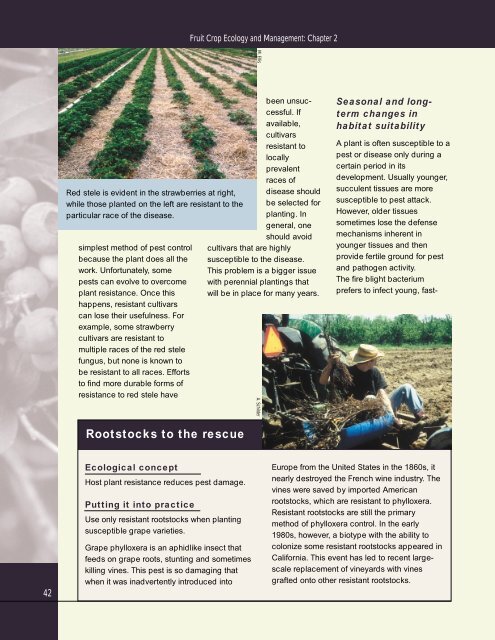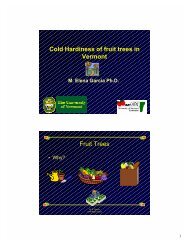Fruit Crop Ecology and Management - UVM Apple Orchard
Fruit Crop Ecology and Management - UVM Apple Orchard
Fruit Crop Ecology and Management - UVM Apple Orchard
You also want an ePaper? Increase the reach of your titles
YUMPU automatically turns print PDFs into web optimized ePapers that Google loves.
42<br />
Red stele is evident in the strawberries at right,<br />
while those planted on the left are resistant to the<br />
particular race of the disease.<br />
simplest method of pest control<br />
because the plant does all the<br />
work. Unfortunately, some<br />
pests can evolve to overcome<br />
plant resistance. Once this<br />
happens, resistant cultivars<br />
can lose their usefulness. For<br />
example, some strawberry<br />
cultivars are resistant to<br />
multiple races of the red stele<br />
fungus, but none is known to<br />
be resistant to all races. Efforts<br />
to find more durable forms of<br />
resistance to red stele have<br />
Rootstocks to the rescue<br />
Ecological concept<br />
Host plant resistance reduces pest damage.<br />
Putting it into practice<br />
Use only resistant rootstocks when planting<br />
susceptible grape varieties.<br />
Grape phylloxera is an aphidlike insect that<br />
feeds on grape roots, stunting <strong>and</strong> sometimes<br />
killing vines. This pest is so damaging that<br />
when it was inadvertently introduced into<br />
<strong>Fruit</strong> <strong>Crop</strong> <strong>Ecology</strong> <strong>and</strong> <strong>Management</strong>: Chapter 2<br />
M. Ellis A. Schilder<br />
been unsuccessful.<br />
If<br />
available,<br />
cultivars<br />
resistant to<br />
locally<br />
prevalent<br />
races of<br />
disease should<br />
be selected for<br />
planting. In<br />
general, one<br />
should avoid<br />
cultivars that are highly<br />
susceptible to the disease.<br />
This problem is a bigger issue<br />
with perennial plantings that<br />
will be in place for many years.<br />
Seasonal <strong>and</strong> longterm<br />
changes in<br />
habitat suitability<br />
A plant is often susceptible to a<br />
pest or disease only during a<br />
certain period in its<br />
development. Usually younger,<br />
succulent tissues are more<br />
susceptible to pest attack.<br />
However, older tissues<br />
sometimes lose the defense<br />
mechanisms inherent in<br />
younger tissues <strong>and</strong> then<br />
provide fertile ground for pest<br />
<strong>and</strong> pathogen activity.<br />
The fire blight bacterium<br />
prefers to infect young, fast-<br />
Europe from the United States in the 1860s, it<br />
nearly destroyed the French wine industry. The<br />
vines were saved by imported American<br />
rootstocks, which are resistant to phylloxera.<br />
Resistant rootstocks are still the primary<br />
method of phylloxera control. In the early<br />
1980s, however, a biotype with the ability to<br />
colonize some resistant rootstocks appeared in<br />
California. This event has led to recent largescale<br />
replacement of vineyards with vines<br />
grafted onto other resistant rootstocks.



